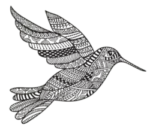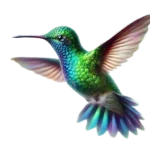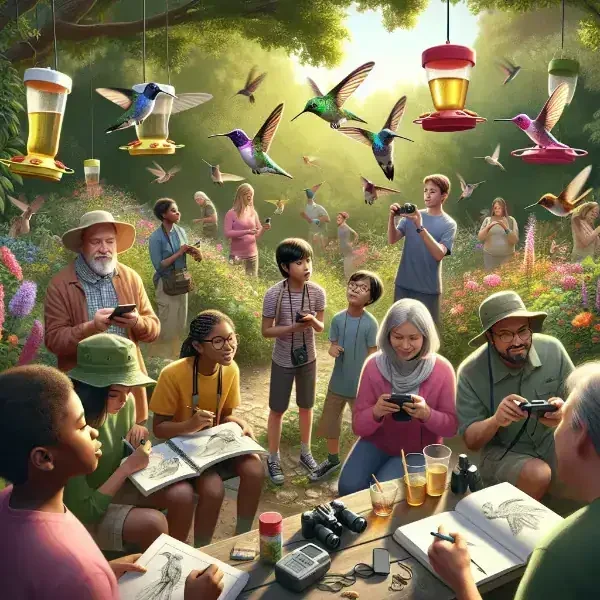(Or: Becoming Part of the Scientific Revolution from Your Own Backyard)
In the evolving world of wildlife research, ordinary citizens have become extraordinary contributors to our understanding of hummingbirds. Armed with smartphones, cameras, and keen observation skills, backyard naturalists across the Americas are helping scientists track migration patterns, monitor population changes, and document behaviors in ways that would be impossible for professional researchers working alone.
The Power of Many Eyes
The study of hummingbirds presents unique challenges for professional scientists. These tiny, fast-moving birds cover vast territories, migrate across continents, and often show up in unexpected places. No research team, no matter how well-funded, could monitor all this activity. This is where citizen scientists become invaluable.
Through organized participation, everyday observers contribute to major research projects:
- Migration tracking across thousands of locations
- Behavior documentation in varied habitats
- Population monitoring over extended periods
Consider how a single backyard observation, when combined with thousands of others, helps create a comprehensive picture of hummingbird movements and behaviors across entire continents.
Getting Started: Basic Tools and Skills
Becoming a citizen scientist doesn’t require expensive equipment or advanced degrees. The most important tools are curiosity, attention to detail, and consistency in recording observations. That said, some basic equipment can enhance your contribution:
- A smartphone with a camera
- A notebook for detailed records
- Access to the internet for data submission
Learning to make accurate observations involves developing key skills:
- Species identification fundamentals
- Behavior recognition patterns
- Standard data recording methods
Major Projects and Platforms
Several established programs welcome citizen scientists interested in hummingbird research. Each project serves different research goals while making participation accessible to observers at all skill levels.
Journey North, for example, tracks hummingbird migration across North America. Participants simply report their first spring and last fall sightings, creating a continental-scale picture of migration patterns. The process is straightforward but the collective data is invaluable to researchers studying climate change impacts on migration timing.
Popular platforms include:
- eBird for population monitoring
- Journey North for migration tracking
- Project FeederWatch for winter observations
- Hummingbirds at Home for behavior studies
Making Quality Observations
The value of citizen science lies in the quality of observations. Learning to make and record observations systematically helps ensure your data contributes meaningfully to research efforts.
Essential observation practices include:
- Recording exact dates and times
- Noting specific behaviors observed
- Documenting environmental conditions
- Taking clear photographs when possible
Beyond Basic Reporting
As you gain experience, opportunities for more advanced participation emerge. Many citizen scientists progress from basic sighting reports to detailed behavior studies or specialized monitoring projects.
Advanced participation might include:
- Monitoring nesting activities
- Recording feeding preferences
- Documenting territorial behaviors
- Tracking individual birds over time
The Technology Connection
Modern technology has revolutionized citizen science participation. Smartphone apps and online platforms make data submission easier than ever, while also helping ensure accuracy through built-in verification systems.
Useful technological tools include:
- Bird identification apps
- GPS location services
- Online data submission forms
- Digital photography for documentation
Contributing to Conservation
Citizen science extends beyond data collection to active conservation efforts. Many participants become involved in habitat protection, education programs, and policy advocacy based on their firsthand observations.
Conservation activities include:
- Creating wildlife-friendly gardens
- Educating community members
- Supporting habitat preservation
- Participating in local planning discussions
The Educational Impact
Participation in citizen science creates valuable educational opportunities for people of all ages. Schools, families, and community groups can use hummingbird research projects as gateways to understanding scientific methods and environmental awareness.
Learning opportunities include:
- Understanding scientific methodology
- Developing observation skills
- Learning about ecosystem connections
- Gaining data analysis experience
Building Community Connections
Citizen science often leads to meaningful connections within local and global communities. Participants share observations, learn from each other, and collaborate on projects that benefit both science and their communities.
Community benefits include:
- Network building with fellow enthusiasts
- Knowledge sharing opportunities
- Collaborative research projects
- Mentorship relationships
The Future of Citizen Science
As technology advances and research needs evolve, citizen science opportunities continue to expand. New projects and platforms emerge regularly, offering increasingly sophisticated ways to contribute to hummingbird research and conservation.
Future directions include:
- Advanced mobile applications
- Artificial intelligence assistance
- Real-time data analysis
- Enhanced collaboration tools
Conclusion: Your Role in Research
Every citizen scientist contribution, no matter how small it might seem, adds to our collective understanding of hummingbirds. Your backyard observations could help identify important patterns, document new behaviors, or alert researchers to environmental changes affecting these remarkable birds.
Remember: When you report a hummingbird sighting or document a behavior, you’re not just making an observation – you’re contributing to a global scientific effort to understand and protect these extraordinary creatures.
Post Script: Some scientists suspect citizen researchers might occasionally notice behaviors that professionals have missed. The hummingbirds maintain their usual focus on their daily activities, but the collective observations of thousands of citizen scientists continue to reveal new insights about their lives.


